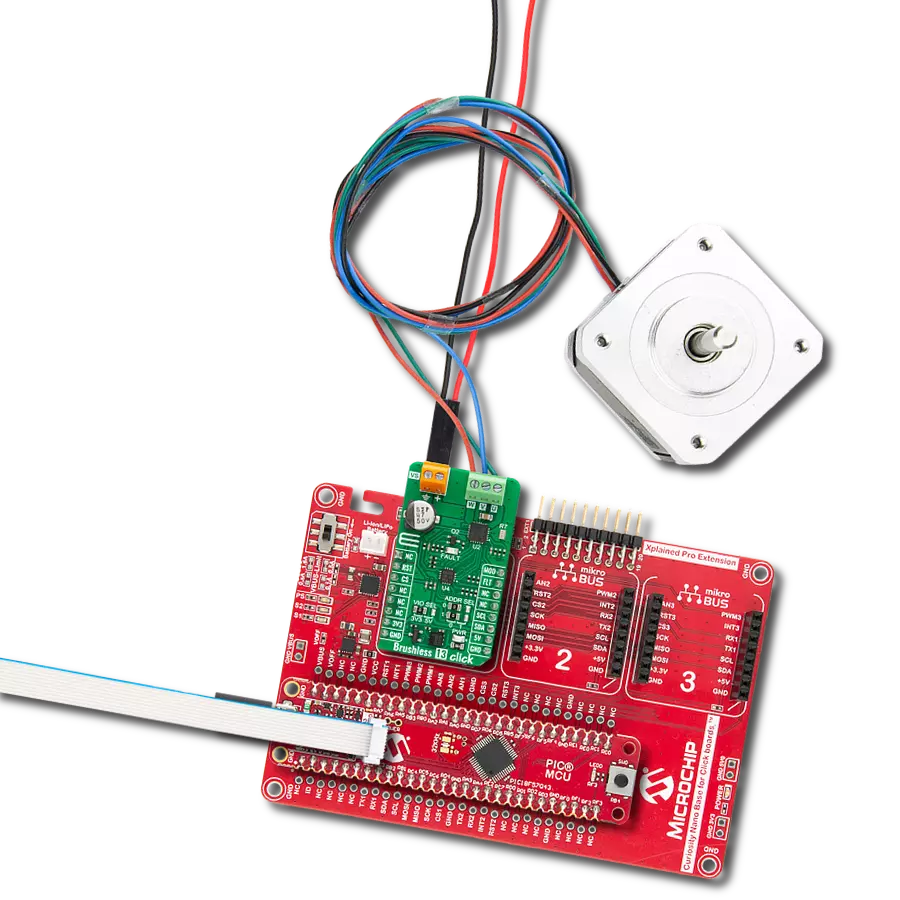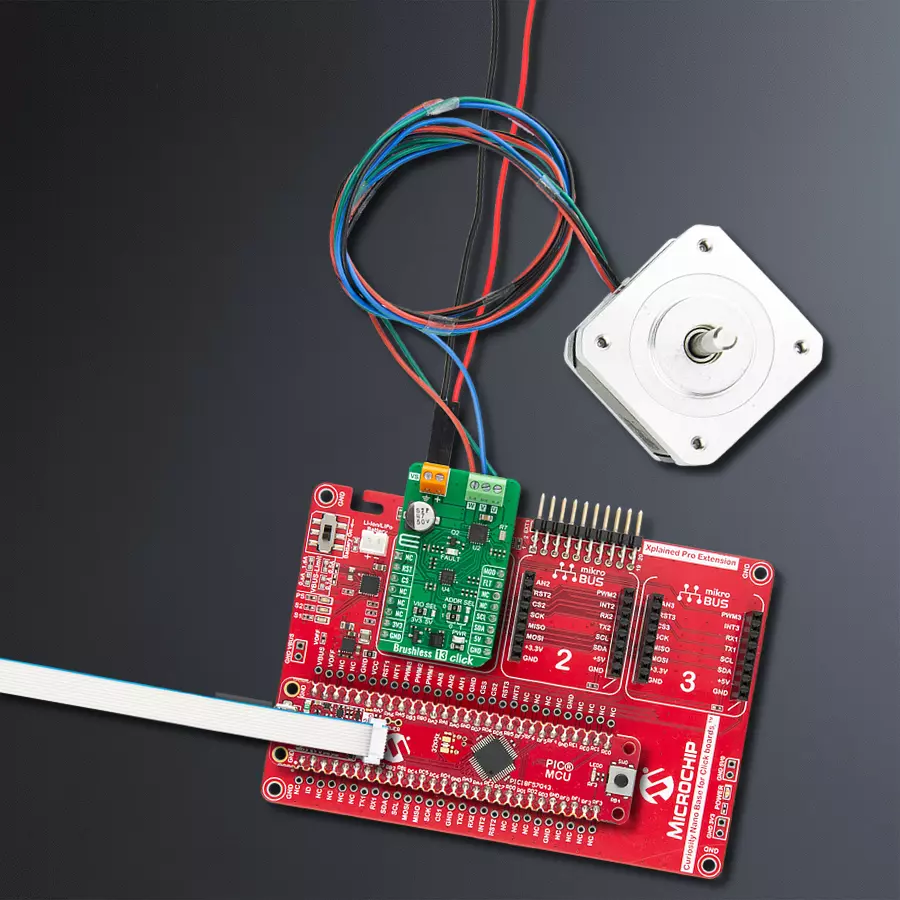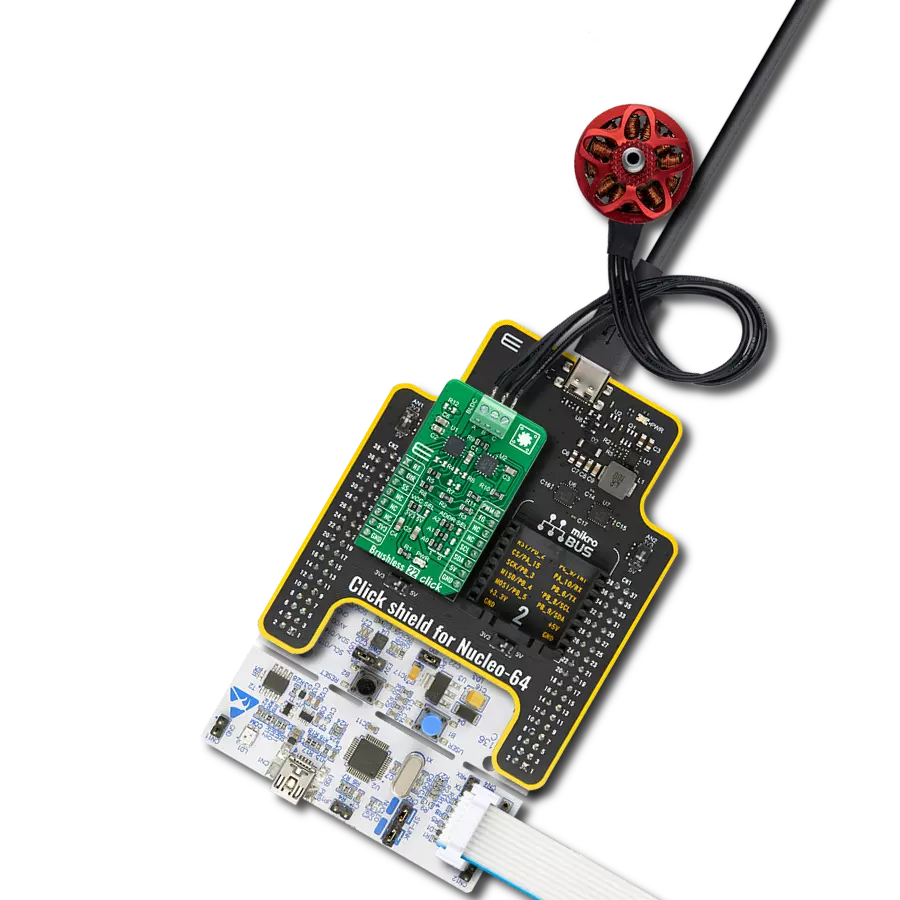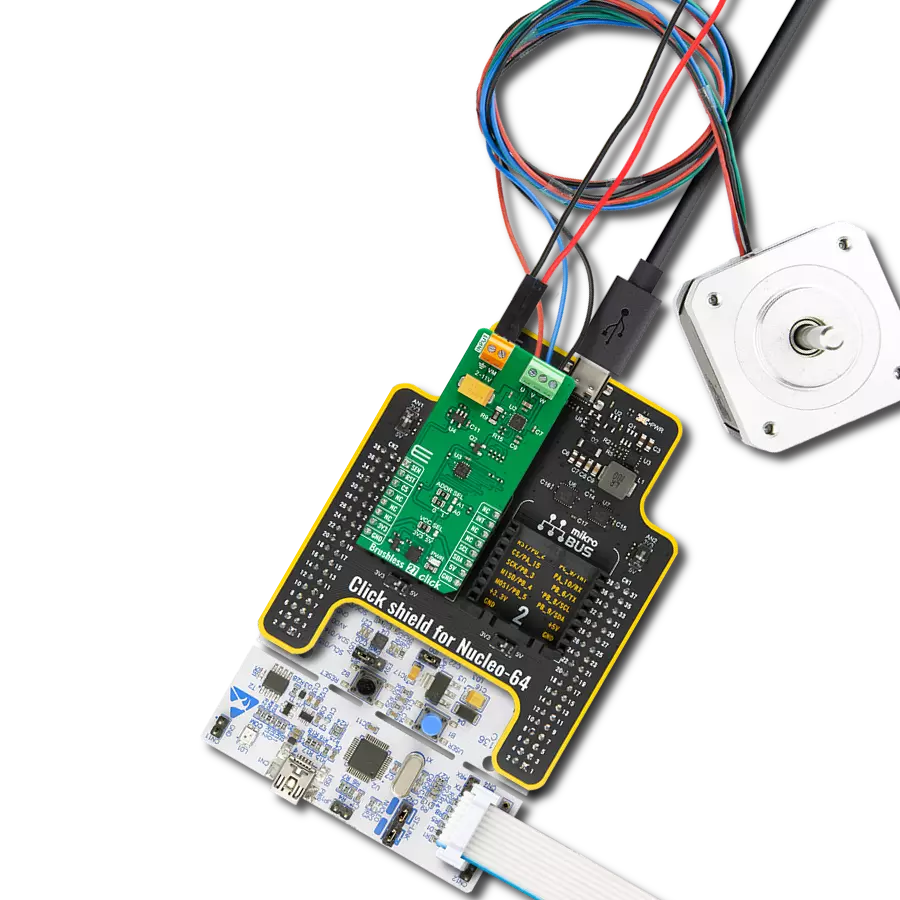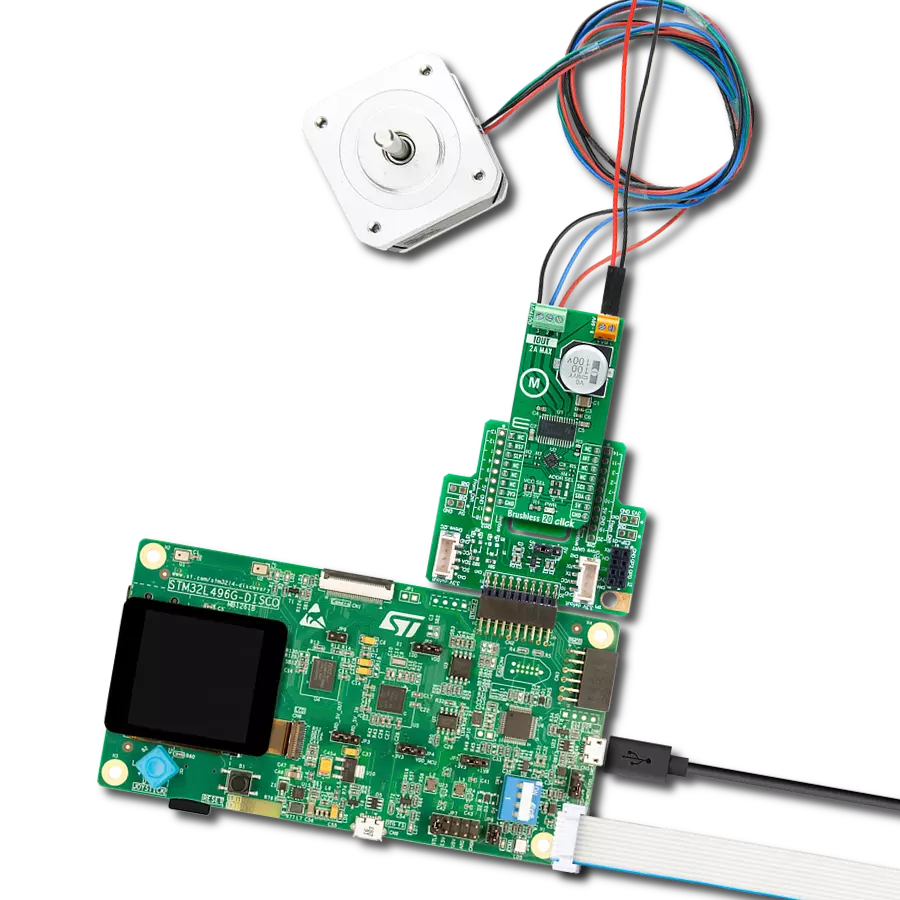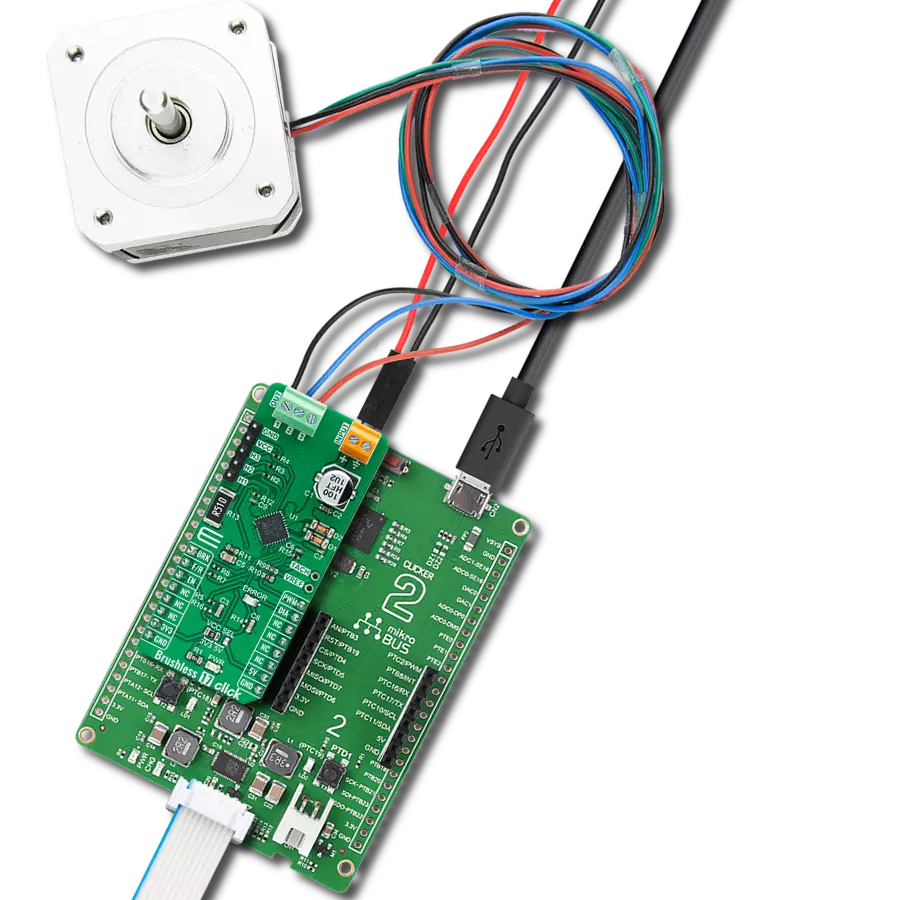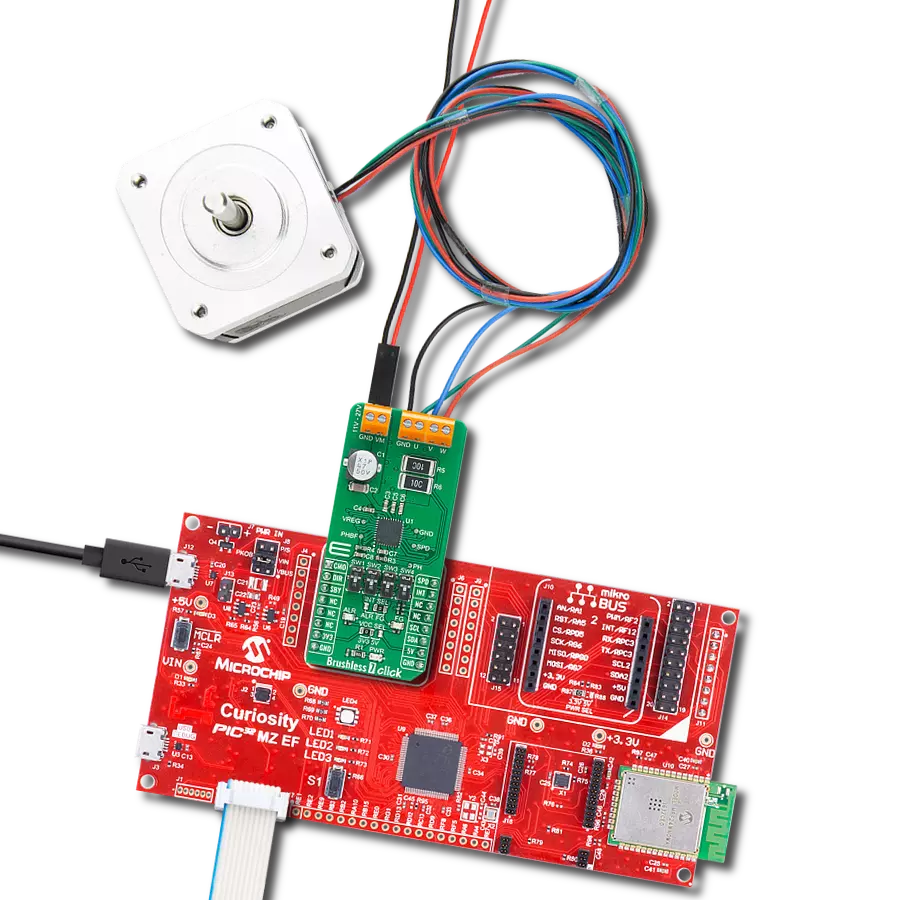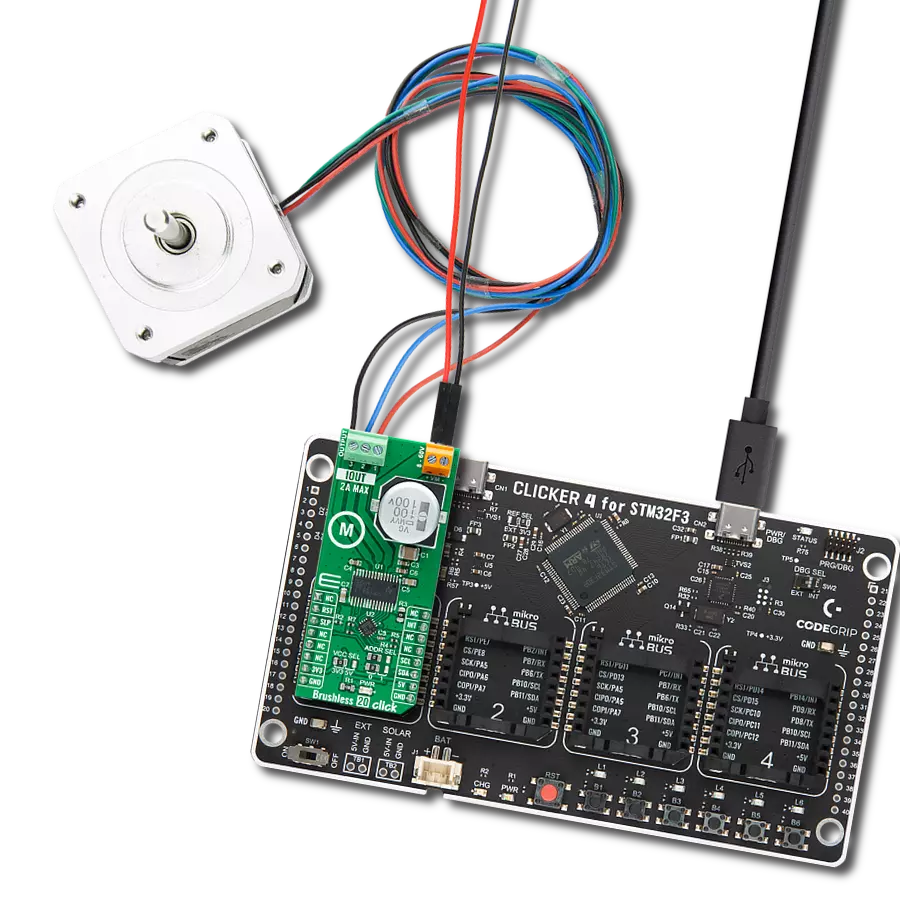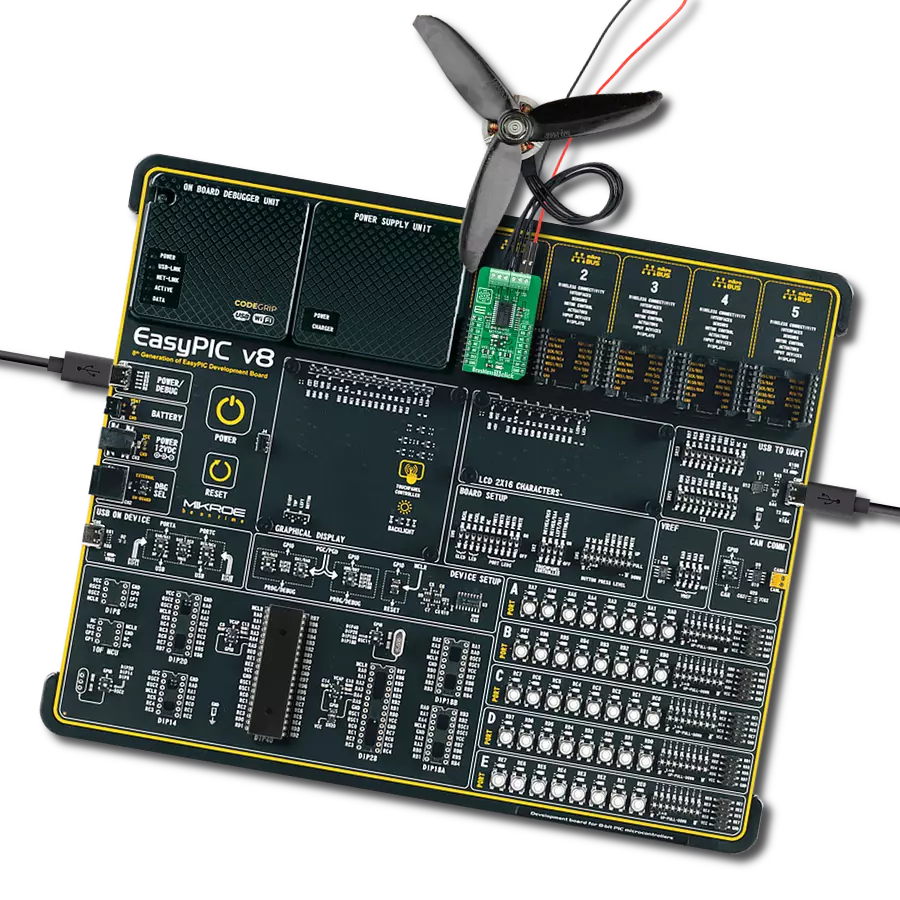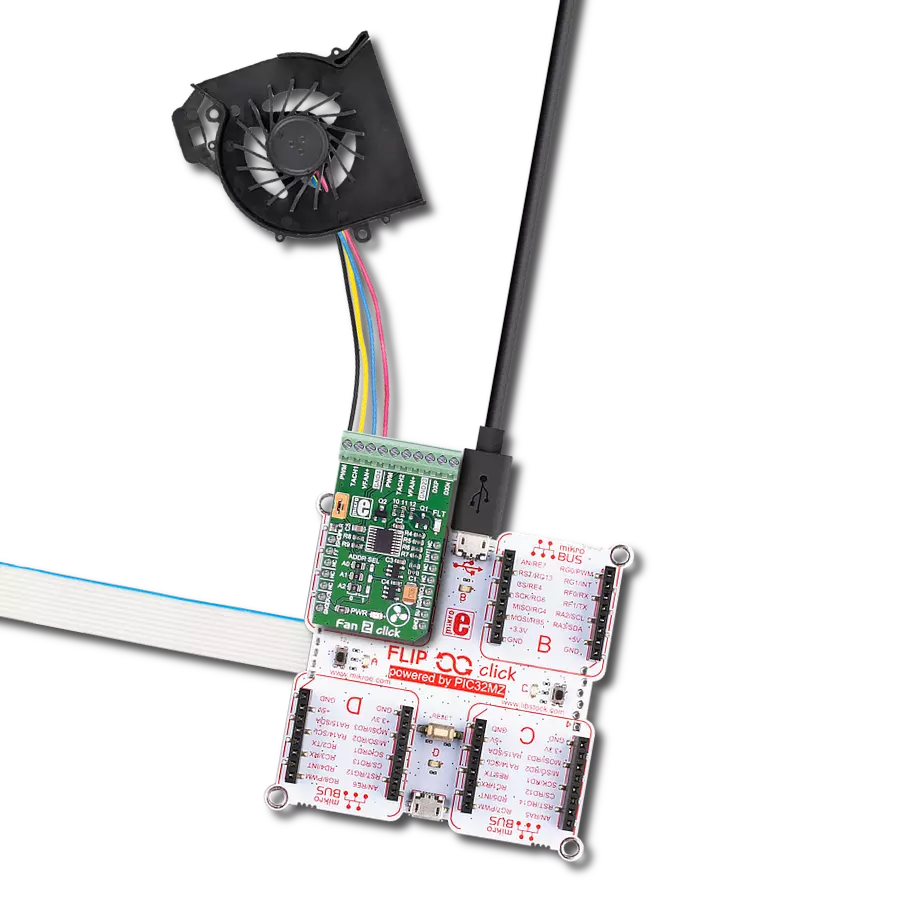Manage the speed, direction, and overall performance of a brushless motor by precisely regulating the flow of electrical power
A
A
Hardware Overview
How does it work?
Brushless 13 Click is based on the STSPIN830, a compact and versatile three-phase and three-sense motor driver from STMicroelectronics. The driver features the dedicated mode input, thus allowing you to decide whether to drive it through six inputs, one for each power switch or, more commonly, three PWM direct driving inputs. The driver integrates a complete set of protections for the power stages, such as non-dissipative overcurrent, thermal shutdown, short-circuit, under-voltage lockout, and interlocking. Considering a low standby current consumption, it makes an ideal and bulletproof solution for the new wave of demanding industrial applications. To control all high and low side driver control inputs
of the STSPIN830, Brushless 13 Click features the PCA9538A, a low-voltage 8-bit I2C I/O port with interrupt and reset from NXP. Besides driver control inputs, this I/O port also controls the enable input of the motor driver. The BLDC motor can be connected over the screw terminal, labeled U, V, and W. Additional screw terminal is just aside for connecting an external power supply in a range of 7V up to 45V. Brushless 13 Click uses a standard 2-wire I2C interface of the PCA9538A to communicate with the host MCU, supporting clock frequencies up to 400kHz. The I2C address of the PCA9538A can be set over the ADDR SEL jumpers, with the 0 position selected by default. If a fault condition occurs, the STSPIN830 will pull
the FLT pin to a low logic state, along with the FAULT LED. The RST pin resets the STSPIN830 motor driver. The driver's mode can be set over the MOD pin, with a HIGH logic state for three PWM direct drive inputs. The LOW logic state will allow a driver to drive the motor through six inputs. This Click board™ can operate with either 3.3V or 5V logic voltage levels selected via the VCC SEL jumper. This way, both 3.3V and 5V capable MCUs can use the communication lines properly. Also, this Click board™ comes equipped with a library containing easy-to-use functions and an example code that can be used as a reference for further development.
Features overview
Development board
PIC18F57Q43 Curiosity Nano evaluation kit is a cutting-edge hardware platform designed to evaluate microcontrollers within the PIC18-Q43 family. Central to its design is the inclusion of the powerful PIC18F57Q43 microcontroller (MCU), offering advanced functionalities and robust performance. Key features of this evaluation kit include a yellow user LED and a responsive
mechanical user switch, providing seamless interaction and testing. The provision for a 32.768kHz crystal footprint ensures precision timing capabilities. With an onboard debugger boasting a green power and status LED, programming and debugging become intuitive and efficient. Further enhancing its utility is the Virtual serial port (CDC) and a debug GPIO channel (DGI
GPIO), offering extensive connectivity options. Powered via USB, this kit boasts an adjustable target voltage feature facilitated by the MIC5353 LDO regulator, ensuring stable operation with an output voltage ranging from 1.8V to 5.1V, with a maximum output current of 500mA, subject to ambient temperature and voltage constraints.
Microcontroller Overview
MCU Card / MCU
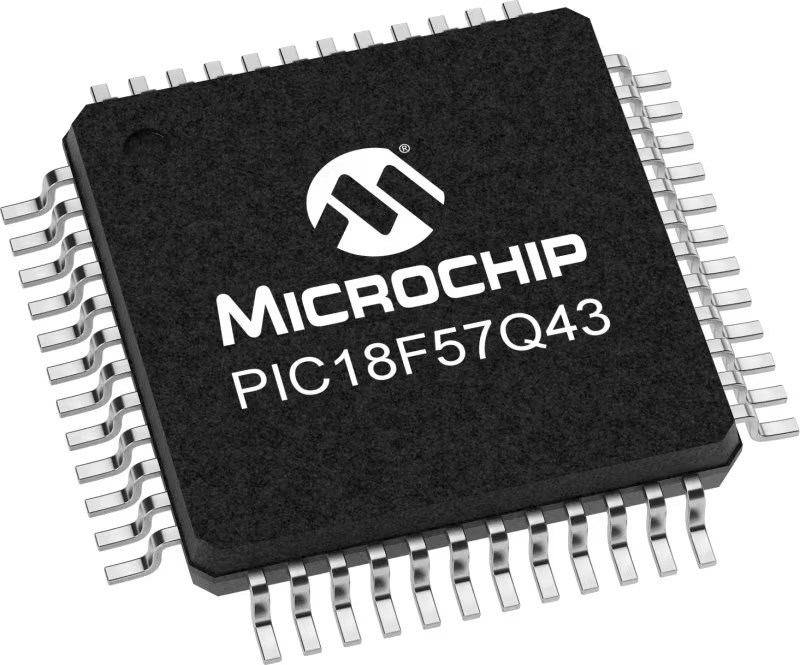
Architecture
PIC
MCU Memory (KB)
128
Silicon Vendor
Microchip
Pin count
48
RAM (Bytes)
8196
You complete me!
Accessories
Curiosity Nano Base for Click boards is a versatile hardware extension platform created to streamline the integration between Curiosity Nano kits and extension boards, tailored explicitly for the mikroBUS™-standardized Click boards and Xplained Pro extension boards. This innovative base board (shield) offers seamless connectivity and expansion possibilities, simplifying experimentation and development. Key features include USB power compatibility from the Curiosity Nano kit, alongside an alternative external power input option for enhanced flexibility. The onboard Li-Ion/LiPo charger and management circuit ensure smooth operation for battery-powered applications, simplifying usage and management. Moreover, the base incorporates a fixed 3.3V PSU dedicated to target and mikroBUS™ power rails, alongside a fixed 5.0V boost converter catering to 5V power rails of mikroBUS™ sockets, providing stable power delivery for various connected devices.
Brushless DC (BLDC) Motor with a Hall sensor represents a high-performance motor from the 42BLF motor series. This motor, wired in a star configuration, boasts a Hall Effect angle of 120°, ensuring precise and reliable performance. With a compact motor length of 47mm and a lightweight design tipping the scales at just 0.29kg, this BLDC motor is engineered to meet your needs. Operating flawlessly at a voltage rating of 24VDC and a speed range of 4000 ± 10% RPM, this motor offers consistent and dependable power. It excels in a normal operational temperature range from -20 to +50°C, maintaining efficiency with a rated current of 1.9A. Also, this product seamlessly integrates with all Brushless Click boards™ and those that require BLDC motors with Hall sensors.
Used MCU Pins
mikroBUS™ mapper
Take a closer look
Click board™ Schematic
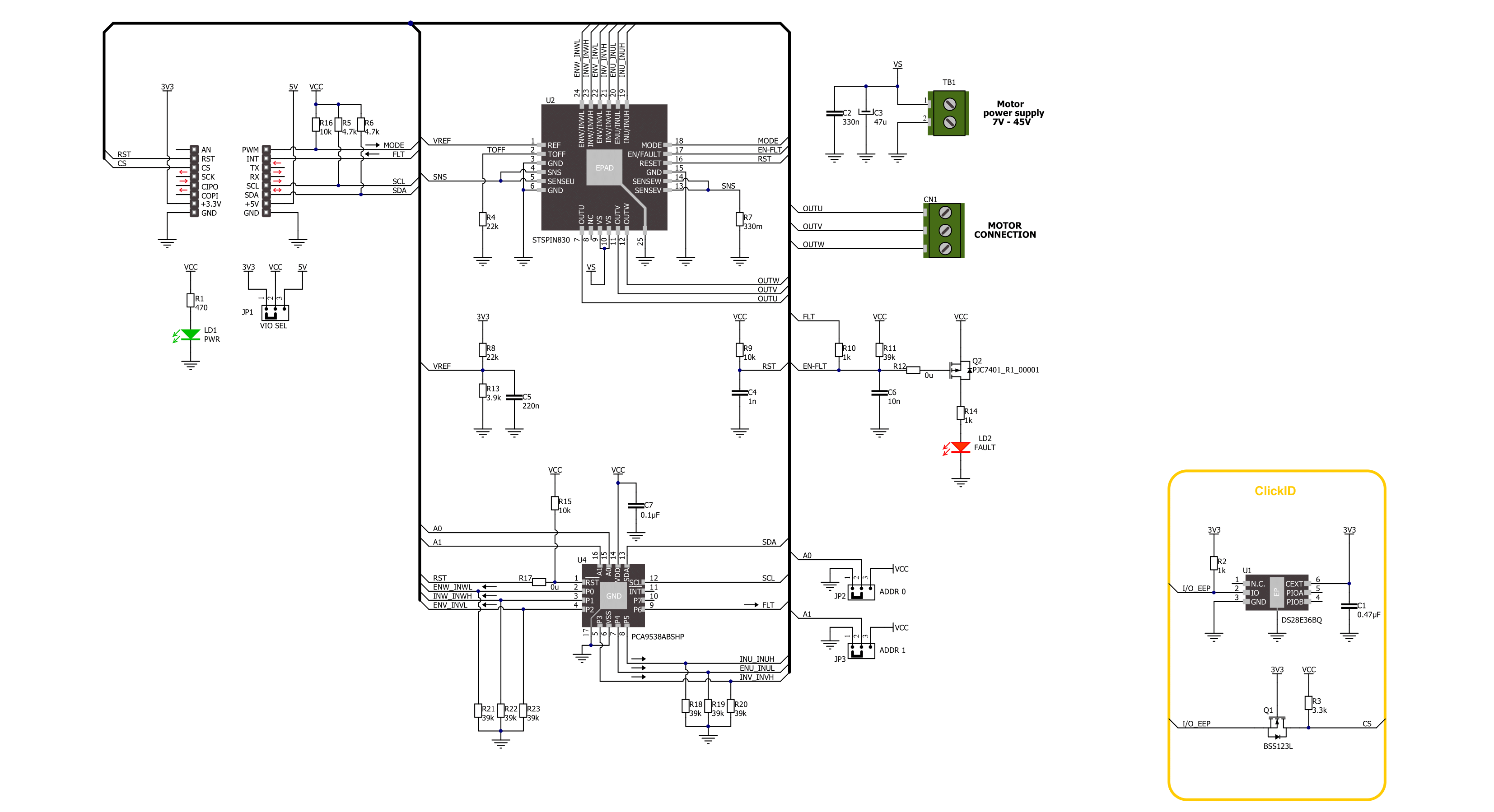
Step by step
Project assembly
Software Support
Library Description
This library contains API for Brushless 13 Click driver.
Key functions:
brushless13_set_mode- Brushless 13 set mode pin function.brushless13_get_flt_pin- Brushless 13 get fault pin function.brushless13_drive_motor- Brushless 13 drive motor function.
Open Source
Code example
The complete application code and a ready-to-use project are available through the NECTO Studio Package Manager for direct installation in the NECTO Studio. The application code can also be found on the MIKROE GitHub account.
/*!
* @file main.c
* @brief Brushless 13 Click example
*
* # Description
* This example demonstrates the use of the Brushless 13 Click board by driving the
* motor in both directions at different speeds.
*
* The demo application is composed of two sections :
*
* ## Application Init
* Initializes the driver and performs the Click default configuration.
*
* ## Application Task
* Drives the motor in both directions and changes the motor speed approximately every 2 seconds.
* The driving direction and speed will be displayed on the USB UART.
*
* @author Stefan Ilic
*
*/
#include "board.h"
#include "log.h"
#include "brushless13.h"
static brushless13_t brushless13;
static log_t logger;
void application_init ( void )
{
log_cfg_t log_cfg; /**< Logger config object. */
brushless13_cfg_t brushless13_cfg; /**< Click config object. */
/**
* Logger initialization.
* Default baud rate: 115200
* Default log level: LOG_LEVEL_DEBUG
* @note If USB_UART_RX and USB_UART_TX
* are defined as HAL_PIN_NC, you will
* need to define them manually for log to work.
* See @b LOG_MAP_USB_UART macro definition for detailed explanation.
*/
LOG_MAP_USB_UART( log_cfg );
log_init( &logger, &log_cfg );
log_info( &logger, " Application Init " );
// Click initialization.
brushless13_cfg_setup( &brushless13_cfg );
BRUSHLESS13_MAP_MIKROBUS( brushless13_cfg, MIKROBUS_1 );
if ( I2C_MASTER_ERROR == brushless13_init( &brushless13, &brushless13_cfg ) )
{
log_error( &logger, " Communication init." );
for ( ; ; );
}
if ( BRUSHLESS13_ERROR == brushless13_default_cfg ( &brushless13 ) )
{
log_error( &logger, " Default configuration." );
for ( ; ; );
}
log_info( &logger, " Application Task " );
}
void application_task ( void )
{
log_printf ( &logger, "\r\n Driving motor clockwise \r\n" );
for ( uint8_t speed = BRUSHLESS13_SPEED_MIN; speed <= BRUSHLESS13_SPEED_MAX; speed += 20 )
{
log_printf ( &logger, " Speed gain: %u\r\n", ( uint16_t ) speed );
if ( BRUSHLESS13_OK != brushless13_drive_motor ( &brushless13, BRUSHLESS13_DIR_CW, speed, 2000 ) )
{
log_error ( &logger, " Drive motor " );
}
}
Delay_ms ( 1000 );
log_printf ( &logger, "\r\n Driving motor counter-clockwise \r\n" );
for ( uint8_t speed = BRUSHLESS13_SPEED_MIN; speed <= BRUSHLESS13_SPEED_MAX; speed += 20 )
{
log_printf ( &logger, " Speed gain: %u\r\n", ( uint16_t ) speed );
if ( BRUSHLESS13_OK != brushless13_drive_motor ( &brushless13, BRUSHLESS13_DIR_CCW, speed, 2000 ) )
{
log_error ( &logger, " Drive motor " );
}
}
Delay_ms ( 1000 );
}
int main ( void )
{
/* Do not remove this line or clock might not be set correctly. */
#ifdef PREINIT_SUPPORTED
preinit();
#endif
application_init( );
for ( ; ; )
{
application_task( );
}
return 0;
}
// ------------------------------------------------------------------------ END
Additional Support
Resources
Category:Brushless
